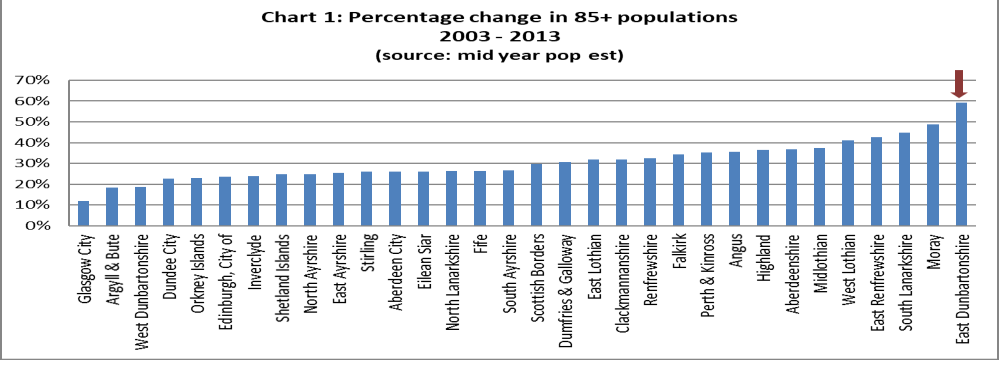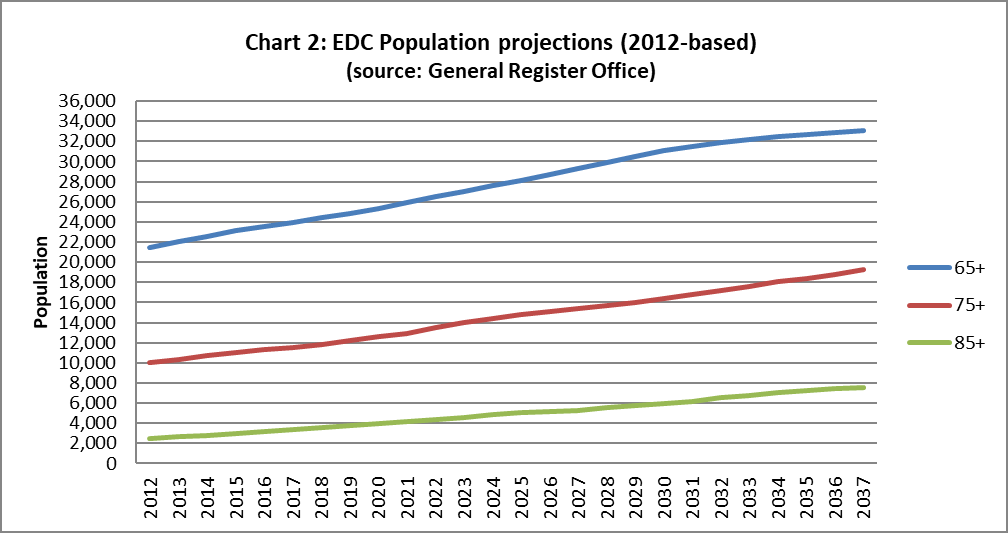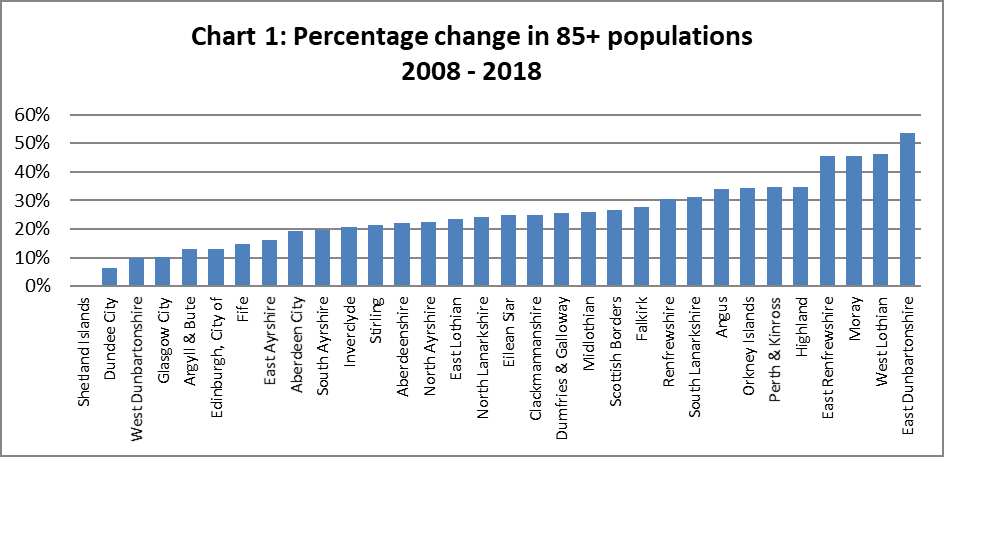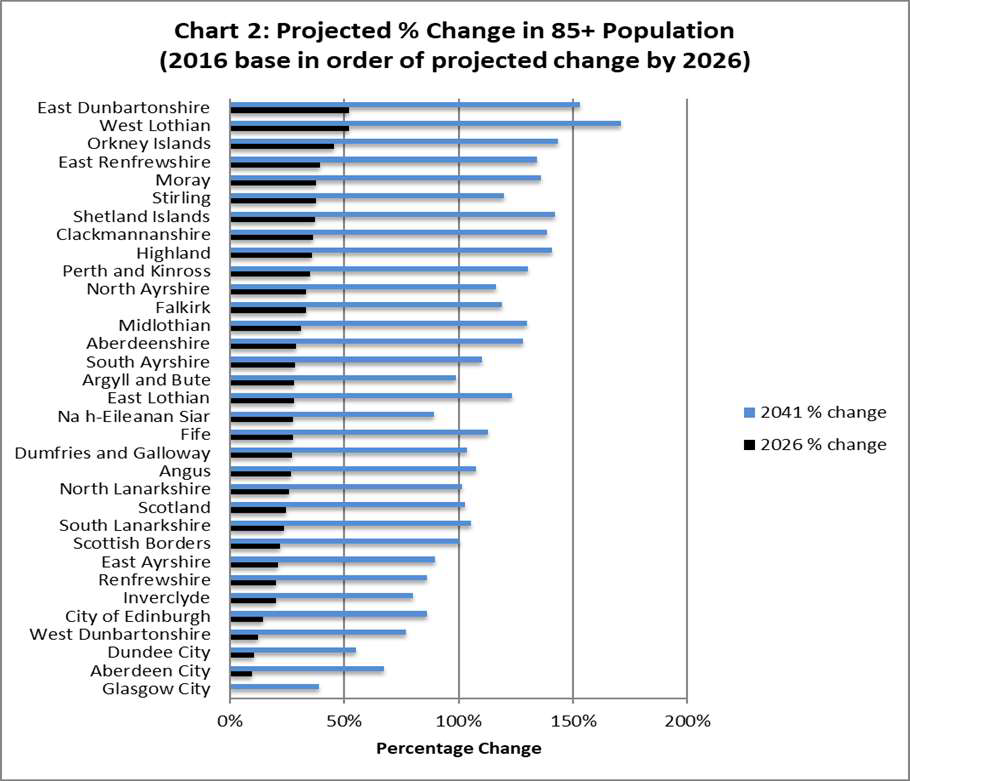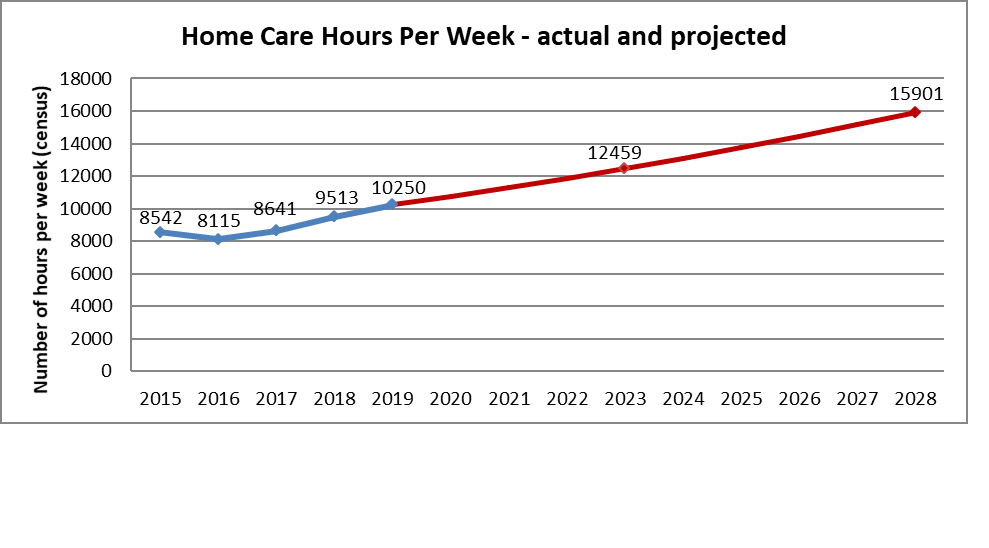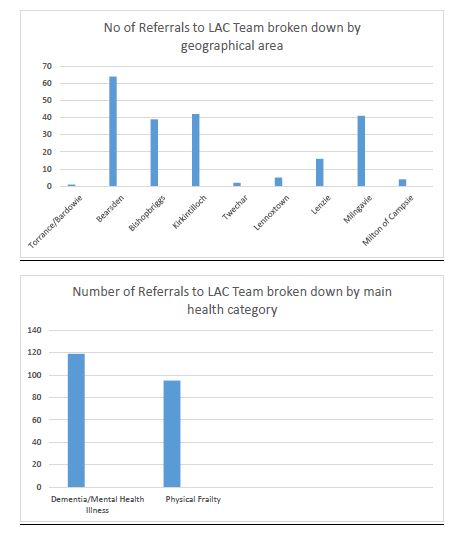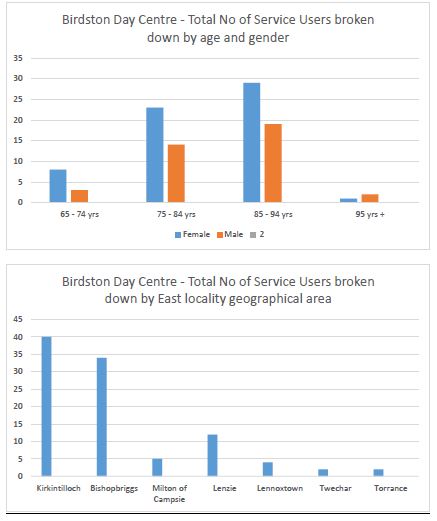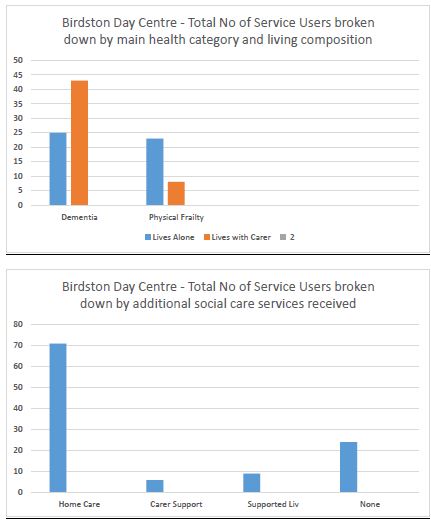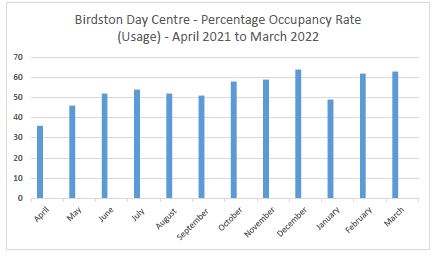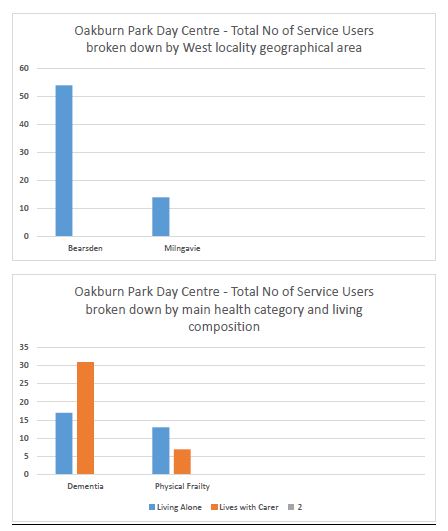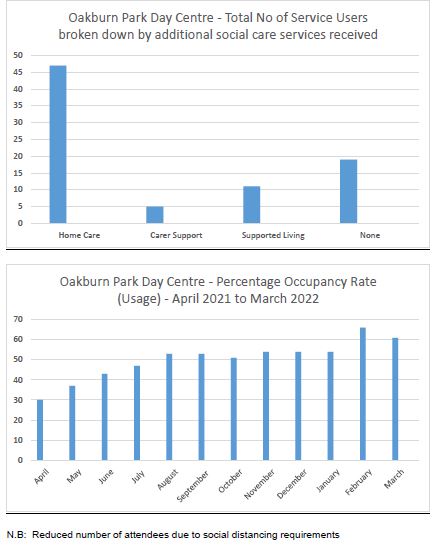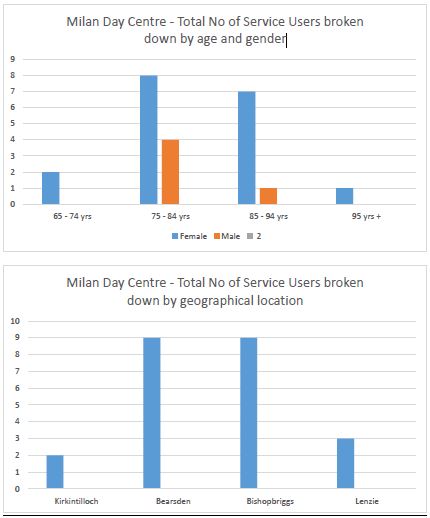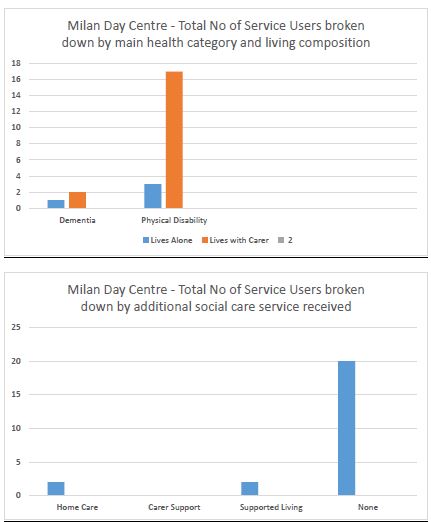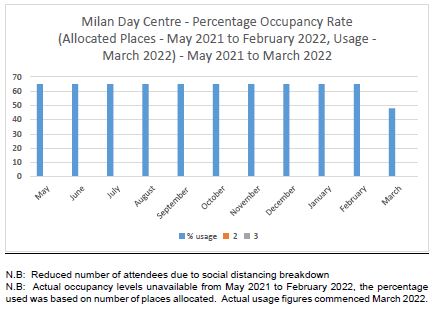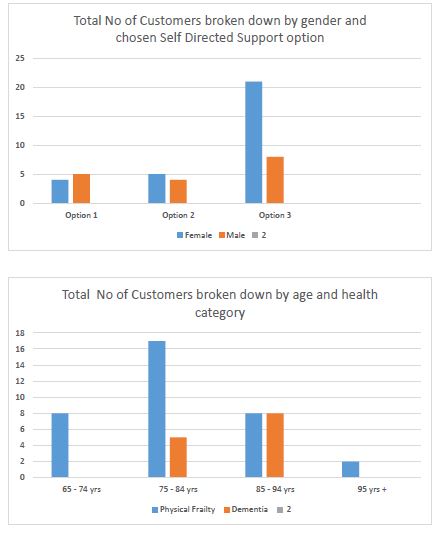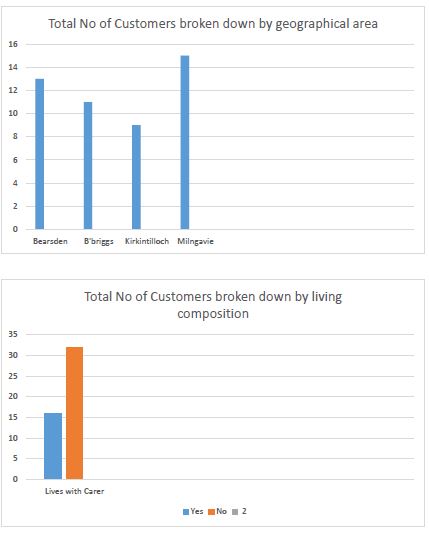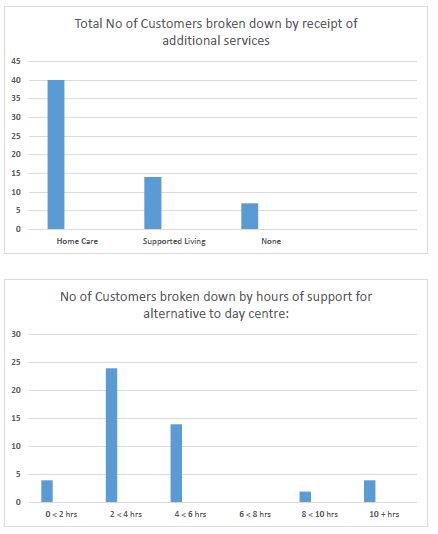Local Demographics
East Dunbartonshire has witnessed the fastest growing increase in people aged 85 years + (59%) of any local authority area in Scotland over the last ten years.
Future projections demonstrate that this growth in older people in our community will accelerate over the next ten years by a further 74%, compared to a Scottish average of 46%.
Looking even further ahead, the population of people 85 years + in East Dunbartonshire is expected to treble over the next 25 years (source: GRO population projections).
The chart below shows the change in the 85 years + population for East Dunbartonshire over the past 10 years, compared to all other HSCP areas in Scotland. In common with the demographic statistics produced in 2014, this demonstrates that East Dunbartonshire has continued to experience the largest increase in this population (by 54%).
The next chart demonstrates that in the 10 years from 2016-2026, the East Dunbartonshire 85 years + population is projected to continue to rise faster than any other HSCP area (by 52%). Looking ahead to 2041, the 85 years + population will continue to rise faster than all HSCP areas (153%), with the exception of West Lothian.
Looking ahead to the next 10 years, further increases are predicted to mirror the increases over the last 10 years, resulting in a doubling of demand over the total period. It is important to stress that this only takes account of service users over age 85 years; almost as many service users receive services between the ages of 75 years and 85 years, as receive services beyond the age of 85 years.
Key factors to consider regarding the demographics contributing to the increase in the number of older people in East Dunbartonshire
- Longer life expectancy resulting not only in more older people, but an increasing prevalence of people surviving beyond age 85 years, with correspondingly higher prevalence of limiting illnesses;
- With increased age comes increased complexity of care needs and associated costs;
- The majority of health and social care services are delivered to those aged 75 years +. In 2012-13, 68% of home care customers were aged over 75 years, with most of these aged over 85 years;
- Most of these statistics in this section relate to the 85 years + population, due to the intensive nature of the care often provided from this age upwards. However, it is important to note that almost as many service users receive services between the ages of 75 years and 85 years as receive services beyond the age of 85 years;
- Community Care policy promotes community-based care, which in the main means care at home, or in a homely place in the community (including care homes). Day Centres or places to provide support in a safe and secure environment are considered an important aspect in
- supporting individuals to remain in the community.
East Dunbartonshire has felt the impact of these increasing numbers of older people and the associated pressures, perhaps more acutely than other areas in Scotland, and this trend is expected to accelerate.
Demographics v Service Demand
During 2015 – 2019, the number of customers receiving home care aged 65+ increased by 26%. Looking ahead to the next ten years, with continued increases in older people and most particularly the 85+ population expected to rise at a rate higher than any other Scottish local authority area, it is projected that East Dunbartonshire will experience a continued 5% year-on-year increase in home care demand. This has a direct correlation with referrals for formal day care or day opportunities support. Current eligibility for attending day care is that customers are in receipt of support of a personal care nature either from home care services or family.
Between 2003 and 2013, East Dunbartonshire experienced the fastest growing increase in people aged 85+ of any local authority in Scotland (from 1,672 to 2,660: an increase of 59%), with steepening future projections
(East Dunbartonshire HSCP: Demand Older People, 2019)
The majority of social care services were delivered to people aged over 75 years; around 70% of home care customers were over 75 years, with the majority of these customers aged 85 years +.
- With approximately 40% of people 85 years+ in receipt of at least one social care service in the community in 2014 (including the meals on wheels service), based on population projections at that time it was estimated that population changes would equate to up to 81 additional service users per year age 85 years+.
- The predicted rise in the population of people aged 85 years + in East Dunbartonshire has come to pass, with consequential pressure on services and resources. In the period 2008-2018, East Dunbartonshire has continued to experience the largest national increase in the 85 years + population from 2,086 in 2008 to 3203 in 2018.
- From 2016-2026, the 85 years + population is projected to continue to rise faster than any other HSCP area by 52% to 4,567. Looking ahead to 2041, the 85 years + population will continue to rise faster than all HSCP areas to 7,582 (an increase of 153% from 2016), with the exception of West Lothian.
- Analysis of the Burden of Disease study indicates that years of life lost to disability and premature mortality in East Dunbartonshire is the second lowest in Scotland.
- Care at home demand (hours of service) has increased by 5% per year between 2015 and 2019, exactly in line with the increase in 85 years + population. Of 1,335 home care customers per week over the age of 65 years, 639 are aged over 85 years (48%), constituting 20% of our 85 years + population.
- With the direct relationship between demographic changes and cost pressures demonstrated in these areas, it can be reasonably anticipated that we will see continued 5% year-on-year increases in demand, reflecting population projections for the 85 years + age-group.
- These pressures are found to be exceptionally the case in East Dunbartonshire, which has experienced the steepest increases in the 85 years + population in the country over the past 10 years and will continue to be the steepest over the next 10 years. The analyses indicate therefore that the demand and cost challenges are going to continue to increase exponentially over the next 10 years and beyond.
(East Dunbartonshire HSCP: Older People Demand Supplementary Report 2019)
Overview of Referrals and Provision
The statistical data for each type of formal social support is correct as 31st March 2022.
Local Area Co-ordination for Older People:
The Local Area Co-ordination (LAC) Team for Older People has received 214 referrals during the period of 1st April 2021 to 31st March 2022. The majority of customer referrals received during that period resided in Bearsden and Kirkintilloch and had a main health diagnosis of Dementia/Alzheimer’s.
Birdston Day Centre:
As at 31st March 2022 there are 99 service users attending Birdston Day Centre, mostly falling into the 85 – 94 years old category. Of those attending the majority are female, living in Kirkintilloch, and suffering from Dementia/Alzheimer’s. Most of those attending the Centre live with an unpaid carer. All those attending the Centre have been assessed as meeting the HSCP’s Eligibility Criteria.
N.B: Reduced number of attendees due to social distancing requirements
Oakburn Park Day Centre:
As at 31st March 2022 there are 68 service users attending Oakburn Park Day Centre, mostly falling into the 85 – 94 years old category. Of those attending there was an even split between the numbers of males and females, however most service users lived in the Bearsden area, suffered with Dementia/Alzheimer’s and lived with an unpaid carer. All those individuals attending the Centre have been assessed as meeting the HSCP’s Eligibility Criteria.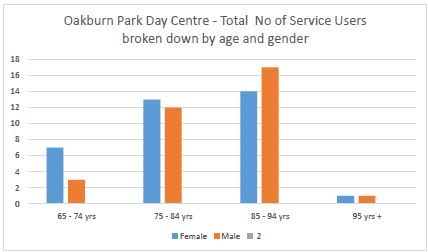
Milan Day Centre:
As at 31st March 2022 there are 23 service users from the Black, Asian, Minority Ethnic (BAME) community attending Milan Day Centre. The majority of those attending fell into the 75 – 84 years old category, however, unlike Birdston and Oakburn Day Centres, the majority of the attendees suffered from physical frailty. The majority of those attending were female, lived with unpaid carers and lived in the Bearsden and Bishopbriggs areas of East Dunbartonshire. All those attending the Centre have been assessed as meeting the HSCP’s Eligibility Criteria.
Alternative to Day Centre:
While a previous needs analysis evidenced that those service users, who met the eligibility criteria for social support, largely chose a formal building based day centre support to meet those needs and outcomes (Self Directed Support Option 3). There were a significant number of service users, which increases each month, who chose to explore alternative ways of meeting social support needs via Self Directed Support Options 1 and/or 2. There can also be situations where the service user would not benefit from attending social care
support in a group setting. In these situations, alternative to day care support can be provided under Self Directed Support Option 3.
As at 31st March 2022 there are 49 service users who could not attend a day centre building or had chosen alternative types of formal social support. The majority of these service users fell into the 75 – 84 years old category, lived with unpaid carers and lived in Milngavie.
Financial Framework
The financial framework underpinning this Strategy is, aligned to the HSCP’s Medium-Term Financial Strategy (MTFS) and establishes the current and projected level of resources required to support delivery of agreed priorities over the next five years.
The budget (2022/2023) for Social Supports is £1,506,436m, and extends across the following commitments:
- Building Based Day Care - £1,052,207 million
- Community Based Support - £253,047
- Third / Voluntary Sector Organisations - £125,745
- Local Area Co-ordinators - £75,437
In Year 5 of the Strategy (2027/2028), the budget is, projected to increase to £1.6m - in line with inflationary uplifts.
